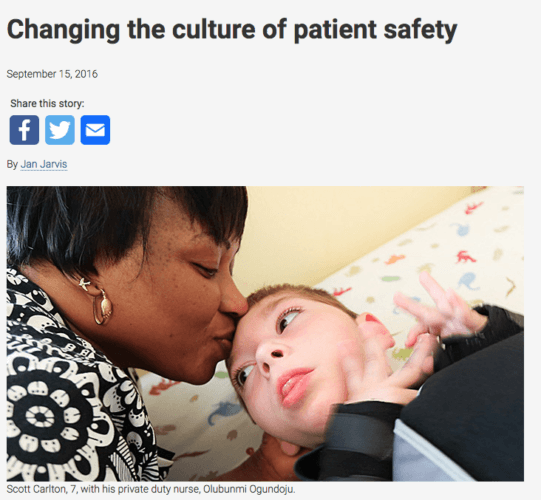I recently saw this article, as published in a printed magazine that arrived in the mail via the UNT Health Science Center.
The bold headline in the magazine was:
FIRST, DO NO HARM
I appreciate it when a healthcare organization can acknowledge the patient safety crisis in their own publication… and it's even better when they can take action to reduce preventable harm and death.
The young patient, Scott, wasn't harmed by a medication error… but there was an error nonetheless. “Defects” in a process should be acknowledged even if there's a “near miss” (the wrong medication isn't given) or an error that doesn't cause harm. Using the knowledge we gain from root cause analysis and process improvement prevents future problems.
From the article, talking about young Scott:
“Jeff Carlton and his wife were leaving the hospital, two days after learning that their infant son had a rare brain disorder called lissencephaly – and a life expectancy of just two years.
Reviewing the discharge paperwork, the distraught parents from Arlington caught a critical mistake: a misplaced decimal point in the dosage prescribed for a drug to control their son's seizures.
“I don't know what 10 times the dosage would do to a 7-week-old kid, but a mistake like that was tough for two emotionally devastated parents to catch,” said Carlton, Director of Media Relations at UNTHSC. “I should not have to do that sort of math on the worst day of my life.”
Though the error was caught in time and caused no harm, it illustrates how a simple mistake can often have huge consequences. Despite protocols to protect patients – from smart pumps to color-coded gowns – an estimated 250,000 Americans die annually due to medical errors, making such mistakes the third most common cause of death in the U.S., according to researchers from Johns Hopkins University.”
Different protocols and technology aren't enough. We need to change the culture and management system, as this article says.
“Key health care organizations in Fort Worth are pushing for change, starting with the new Institute for Patient Safety at UNT Health Science Center. Founding partners include Cook Children's Medical Center, JPS Health Network and Texas Christian University.”
Unfortunately, I missed their first Patient Safety Summit because of work travel and the AME Conference.
Agree that healthcare can't continue to say, “Well, these things are going to happen.” Yes, there are many positive results and a lot of loving care in our system (Scott Carlton far exceeded his life expectancy of two years)… but there's too much harm.
“For 30 years the health care industry has tried to improve patient safety, but in all that time we've hardly moved the needle,” said Michael Hicks, MD, Executive Vice President for Clinical Affairs at UNT Health Science Center. “Reducing medical mistakes calls for more than protocols; it calls for cultural change and a new way of doing the business of health care.
“We simply have to expect better.”
We have to expect better… and then roll up our sleeves to do the work that's necessary to change the culture.
Read more about their institute and their plans… how do we create a “universal culture of safety throughout our state” – and beyond?
Please scroll down (or click) to post a comment. Connect with me on LinkedIn.
Let’s build a culture of continuous improvement and psychological safety—together. If you're a leader aiming for lasting change (not just more projects), I help organizations:
- Engage people at all levels in sustainable improvement
- Shift from fear of mistakes to learning from them
- Apply Lean thinking in practical, people-centered ways
Interested in coaching or a keynote talk? Let’s talk.
Join me for a Lean Healthcare Accelerator Trip to Japan! Learn More










